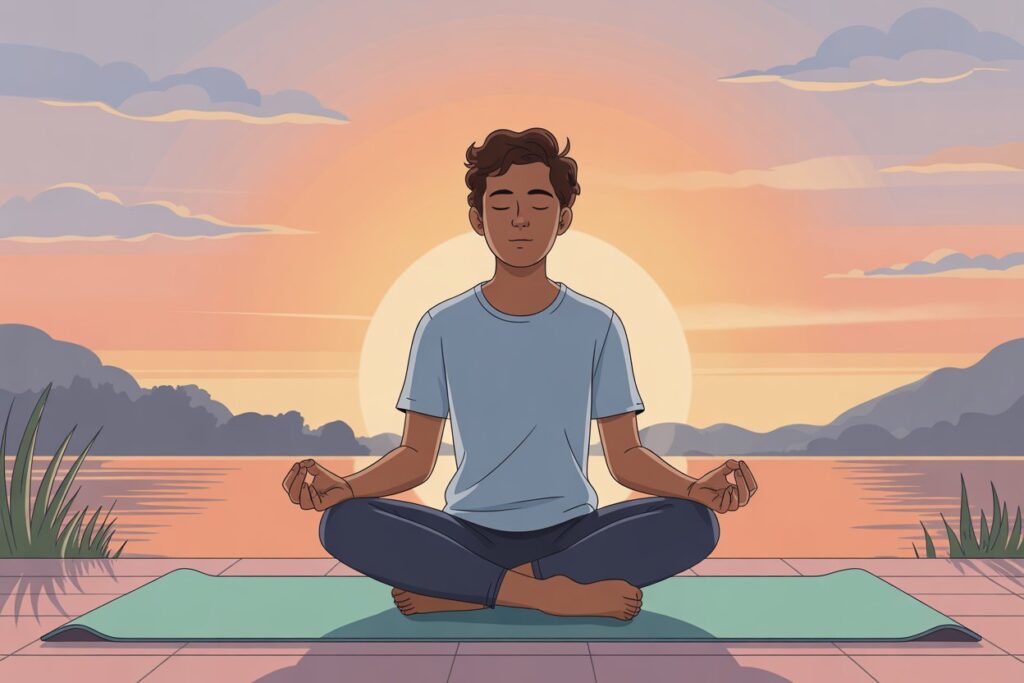INTRODUCTION
Life for young adults in India today is busy and often overwhelming. Whether it’s balancing studies, jobs, or social life, stress and pressure can take a toll on mental wellbeing. The truth is, you don’t need expensive retreats or long therapy sessions to start feeling better. Small habits, repeated daily, can create big changes in how you feel and function.
Here are 7 simple, science-backed daily habits you can try. Start with one or two, stick to them, and you’ll notice positive changes within weeks.
1. Breathe for 5 minutes — start with one focused breath
Why it works: Deep breathing activates the parasympathetic nervous system, lowering stress hormones like cortisol. A 2017 study published in Frontiers in Psychology found that slow breathing improves emotional control and focus.
Action step: Sit comfortably. Inhale through your nose for 4 seconds, hold for 1, exhale through your mouth for 6. Do this for just 5 minutes in the morning or before bed.

2. Move your body — even a 15-minute walk helps
Why it works: Exercise releases endorphins, the body’s natural “feel-good” chemicals. The World Health Organization (WHO) notes that even 150 minutes of light activity per week reduces anxiety and depression risk.
Action step: Take a brisk 15–20 minute walk in the evening. If you live in a city, even walking around your colony or terrace works.
3. Sleep like it matters (because it does)
Why it works: Lack of sleep affects concentration, mood, and even immune strength. According to AIIMS Delhi research, Indian young adults often average less than 6 hours of sleep, well below the recommended 7–9.
Action step: Fix a bedtime and wake-up time. Keep your phone away 30 minutes before bed and use dim light to signal your body it’s time to rest.

4. One-minute journal (gratitude + check-in)
Why it works: Journaling helps process emotions and build gratitude. A study from the University of California showed gratitude journaling improves optimism and wellbeing.
Action step: Write two quick lines: “I’m grateful for ___” and “Today I feel ___.” Don’t worry about grammar — it’s for you, not anyone else.

5. Eat a brain-friendly snack (protein + fruit/veg)
Why it works: Diet affects mental health. High sugar snacks spike energy but crash it later, leading to irritability. Balanced snacks with protein and fiber keep mood stable.
Action step: Swap chips with nuts and fruit. A simple combo: almonds + apple slices, or yogurt with banana.

6. Practice a one-minute mental reset
Why it works: Stress builds up during the day. A quick pause interrupts the cycle and gives your brain space. Research on mindfulness shows that even short practices improve attention and reduce stress.
Action step: Close your eyes, place feet flat on the floor, take 3 deep breaths, and feel your body relax. Repeat whenever you feel overwhelmed.

CONCLUSTION
Building mental wellbeing doesn’t need grand gestures. By choosing small habits like walking, journaling, or a mindful breath, you take charge of your mood and focus. Start small, be consistent, and give yourself patience — progress is the real goal.
At MindHope, we believe in practical, science-backed mental health tips for young India. For more ideas, check out our MindHope Stress Relief Guide. and Simple Mindfulness Practices.
For global mental health resources, see the World Health Organization’s mental health page.
FAQs
Q1: How long does it take to feel benefits from these habits?
Most people feel small changes within a week. Consistent practice for 4–6 weeks brings stronger results.
Q2: Can these habits replace therapy or medication?
No. These are supportive practices. If you face severe anxiety or depression, seek professional help.
Q3: Do I need to do all 7 habits daily?
Not at all. Start with one or two, get comfortable, then add more gradually.
